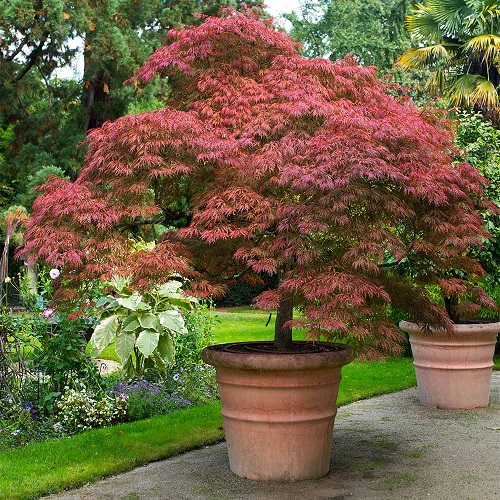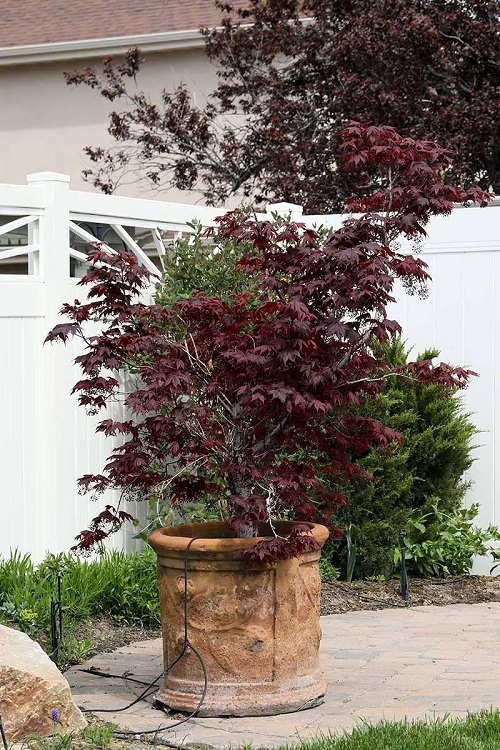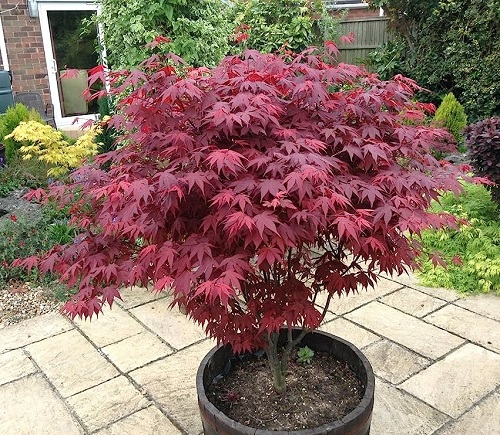Tamukeyama Japanese Maple can be a fantastic specimen for both gardens and pots. Here are all the details to grow it!
Tamukeyama Japanese Maple is a popular cultivar of the Japanese maple tree known for its striking foliage and graceful form. Here’s all the information about growing it easily.
Find How to Grow a Japanese Maple Tree in a Pot here
Tamukeyama Japanese Maple Information
The Tamukeyama Japanese Maple (Acer palmatum ‘Tamukeyama’) is a small to medium-sized deciduous tree that typically grows to a height of 8 to 12 feet (2.4 to 3.7 meters) and spreads to a similar width. It has a rounded, cascading form with multiple branching.
One of the main attractions of the Tamukeyama is its stunning foliage. The leaves are deeply divided and palm-shaped, with five to nine lobes. They emerge in spring with a vibrant reddish-purple color, which darkens as they mature during summer.
In the fall, the foliage turns a brilliant crimson or scarlet, creating a spectacular display.
Here are Japanese Garden Plants You Can Grow Indoors
How to Propagate Tamukeyama Japanese Maple
Grafting is the most reliable way to propagate and maintain the desirable characteristics of the Tamukeyama Japanese Maple.
- Choose healthy, disease-free branches from an established Tamukeyama Japanese Maple tree during late winter or early spring when the tree is dormant. Select 6 to 8-inch (15 to 20 cm) long stems with multiple buds.
- Select a compatible rootstock, such as a seedling or another Acer palmatum variety, that will provide a strong root system for grafting the scion.
- Make a slanting cut on the rootstock and a matching cut on the scion. Join the two cuts together and bind them securely using grafting tape or grafting wax. Keep the graft union protected and moist until it establishes.
- Once the graft has been taken, usually after a few weeks, gradually acclimate the new plant to outdoor conditions.
Check out the Best Narrow Trees for Containers & Small Gardens here
Requirements for Growing Tamukeyama Japanese Maple
Sunlight
This plant thrives in partial shade to full sun. In regions with hot summers, it benefits from some afternoon shade to protect the foliage from scorching. However, it can tolerate full sun if provided with adequate moisture.
Soil
Well-drained soil is crucial for the health of Tamukeyama Japanese Maple. It prefers slightly acidic to neutral soil with a pH range of 5.5 to 7.5. The soil should be rich in organic matter and able to retain moisture without becoming waterlogged.
Here is How to Check Your Soil pH at Home
Water
It has average water needs and requires regular watering, especially during dry periods, to keep the soil consistently moist.
Here are the best ways to water plants
However, it’s important to avoid overwatering, as excessive moisture can lead to root rot. Applying a layer of mulch around the base of the tree helps retain soil moisture.
Temperature Range
The optimal temperature range is between 60°F (15°C) and 75°F (24°C) during the growing season. It can tolerate higher temperatures, but it may require additional watering and protection from direct sunlight to prevent leaf scorch.
In areas with extreme heat, providing some shade and sufficient water is important to prevent stress.
Tamukeyama Japanese Maple Care
Fertilizer
The plant benefits from regular fertilization to promote healthy growth and vibrant foliage. Use a balanced, slow-release fertilizer specifically formulated for acid-loving plants or a general-purpose fertilizer with a balanced NPK ratio.
Here is Dried Banana Peel Powder Fertilizer at Home for Any Plant
Follow the manufacturer’s instructions for application rates and timing. It’s generally recommended to fertilize in early spring before new growth appears and again in late spring or early summer.
Pests and Diseases
- One of the most frequent pests is aphids, which are small, soft-bodied insects that feed on the sap of the tree.
- Scale insects are another concern, appearing as small bumps on branches and leaves.
- Japanese beetles can be problematic as well, as they feed on the foliage, leaving skeletonized leaves in their wake.
To manage these pests, various methods can be employed, including physical removals, such as handpicking or spraying water to dislodge them, using insecticidal soaps or oils, or attracting natural predators like ladybugs to control aphids.
One common disease that can affect the Tamukeyama Japanese Maple is verticillium wilt. Another potential problem is powdery mildew, a fungal infection that manifests as a white powdery coating on the leaves, leading to their distortion and stunted growth.
Here is How to Dispose of Diseased Plants and Weeds
Regular inspection, proper care, and prompt treatment can help mitigate the impact of these diseases and preserve the health and beauty of the Tamukeyama Japanese Maple.




